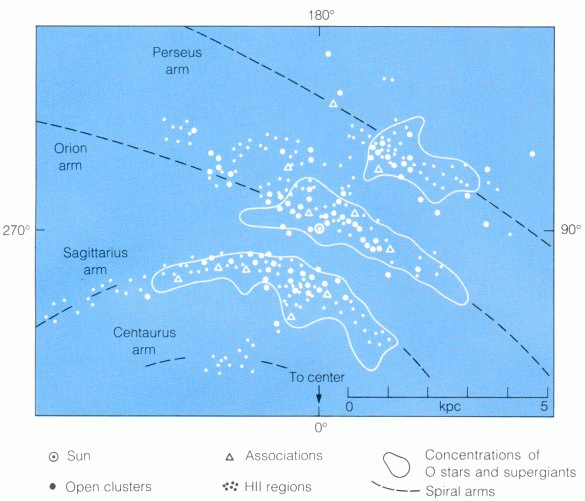
|
Spiral Structure in the Galaxy:
| Readings: Schneider & Arny: Unit 71, 73 |
| (Audio Lecture) |
It is difficult to measure the structure of our Galaxy since we are inside it (trying to see the forest from the trees). One method is to plot the position of tracers, such as young stars or molecular clouds. One such plot is shown below, the position of nearby HII regions and young clusters of stars. Since their age is young, then they will not have drifted far from their formation places.

Interstellar extinction prevents a map much larger than the one above for optical tracers, but even this plot is enough to show that there are distinct arms of material in the Galaxy. Maps of neutral hydrogen show the global spiral pattern throughout the Galaxy.
It is somewhat surprising that we even see a spiral pattern since the Galaxy does not rotate as a solid body. After a few rotations, the spiral pattern would be wound up very tight, as shown in the diagram below. This is known as the winding dilemma.

One explanation for the winding dilemma is to use density waves. Imagine a scenario such as shown below.
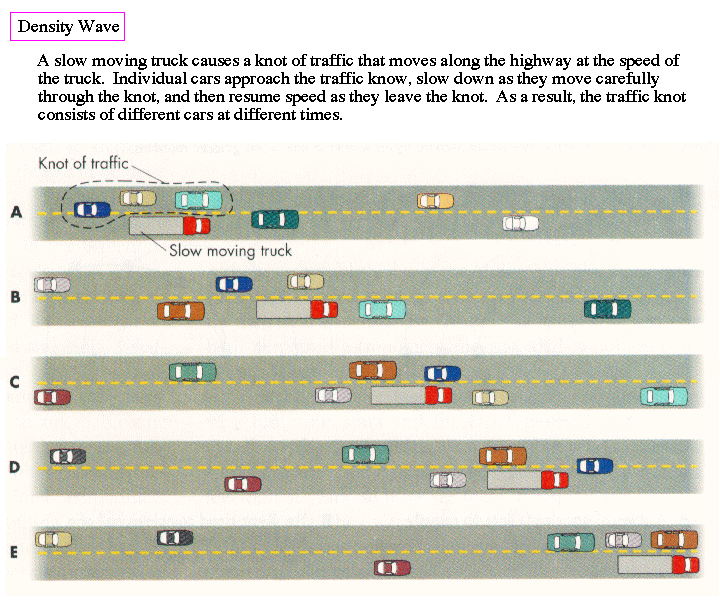
Even though all the cars and trucks are moving at different velocities, there is an apparent overdensity near the slow moving truck. A similar explanation is proposed for spiral arms in our Galaxy, they exist because they exert a gravitational influence on stars and gas that orbit the Galaxy. In particular, gas clouds will orbit slower in the arms and, thus, the density goes up in this region. The spiral arms don't wind up because they are not made of material arms, but rather density patterns that shift like cars in traffic.
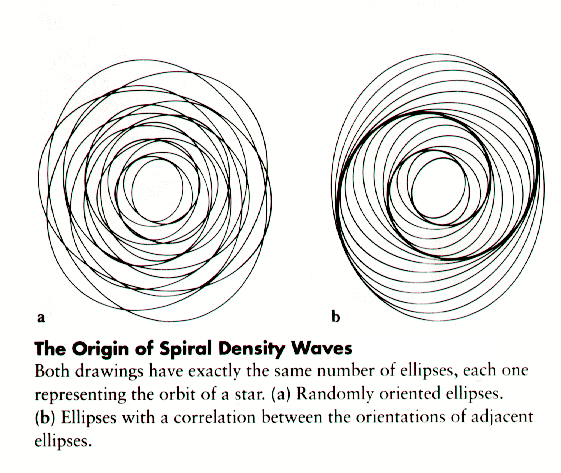
The concentration of gas in the spiral arms explains why neutral hydrogen maps trace spiral structure, but why do young stars occur in spiral arms. Higher density of gas means more gas clouds and cloud collisions. This sparks star formation, which leads to HII regions and young clusters. As the young stars age, they drift out of the spiral pattern.
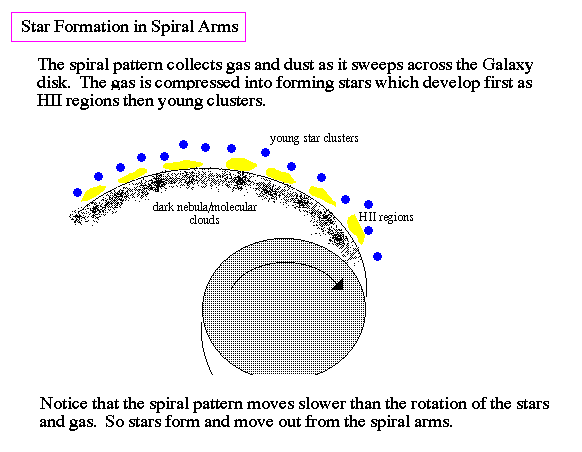
Center of the Galaxy:
The center of the Galaxy is obscured from us by thick interstellar clouds of gas and dust. We can observe the Galactic bulge as an ellipse of stars above and below the Galactic plane. In the solar neighborhood, the stellar density is about one star per cubic parsec (one parsec is 3.26 light-years). At the Galactic core, around 100 parsecs from the Galactic center, the stellar density has risen to 100 per cubic parsec, crowded together because of gravity.
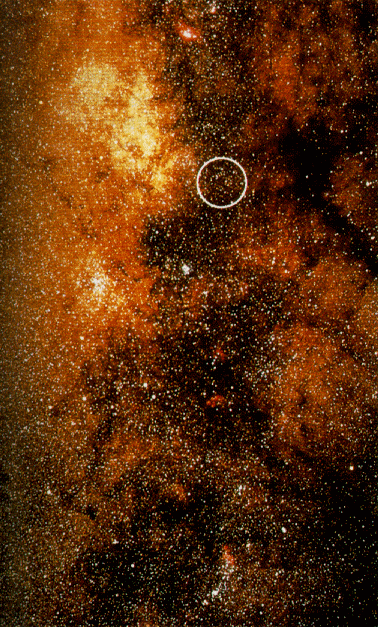
Very near the center of the Galaxy, the stellar densities rise to several hundreds of thousands of stars per cubic parsec. The stars are separated by light-weeks rather than years. Starlight at night is bright enough to read by, although there is a great deal of dust in the Galactic core and much of the energy is radiated in the IR.
As one approaches the Galactic center, not only does the number of stars increase, but a thin ring of gas and dust forms visible by its radio radiation. Streamers of gas are visible in the image below, suggesting an accretion disk over 10 parsecs in size.
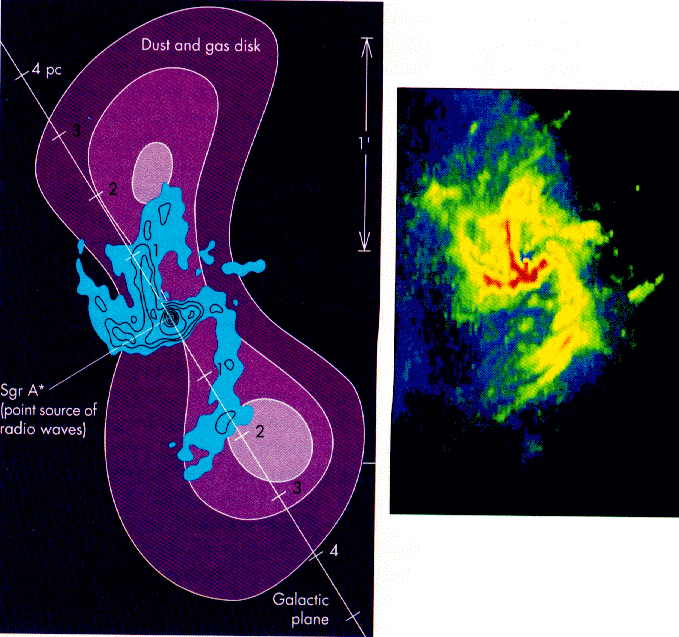
The rotation speeds of this inner gas ring indicates that the object located at Sgr A is less than 13 A.U.s in size and masses over 1 million solar masses. Only a black hole of massive proportions would satisfy these requirements.
Given all above information, the following is a trip to the Galactic core.
Stellar Populations:
A group of stars within the Galaxy that resemble each other in spatial distribution, chemical composition or age are called a stellar population. Stellar populations are not discrete in their properties, but rather have a continuum of characteristics that reflect the changes in star formation with time. Stellar populations are tracers of events in our Galaxy's past and formation.
There are basically three stellar populations in our Galaxy, corresponding to the three distinct dynamical components to the Galaxy; the disk population, the bulge population and the halo population. The disk population inhabits the rotating, flattened region of our Galaxy. The bulge population is restricted to the rounded, central region of the Galaxy, also rotating. And the halo population inhabits the far outer regions of the Galaxy, on long ellipisodal orbits that takes it into the disk and bulge.
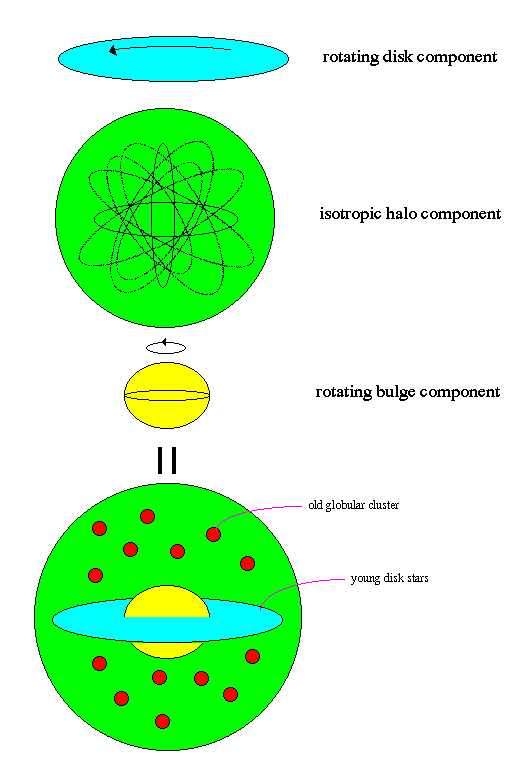
The three components not only have distinct kinematic properties, but the types of objects in them also varied. The disk contains all the gas and young stars, although old stars are also found there. The bulge is dominated by old stars and a violent core. The halo contains very old stars and globular clusters. The reason for this separation of stellar types is a clue to how the Galaxy formed.
Once the distinct kinematic components of the Galaxy had been isolated, an interesting fact arose in that the chemical composition of the stars in those components also varied in a regular manner. Disk and bulge stars tend to be rich in heavy elements (above helium on the periodic table). Halo stars tend to be very poor in heavy elements.
Changes in the chemical composition of a star are due to the initial chemical composition of the gas cloud that it was born from. This heavy elements are mostly produced by supernova explosions, gas clouds become enriched by the ejecta of supernova. The larger the number of supernova near a cloud, the richer in heavy elements it will become.
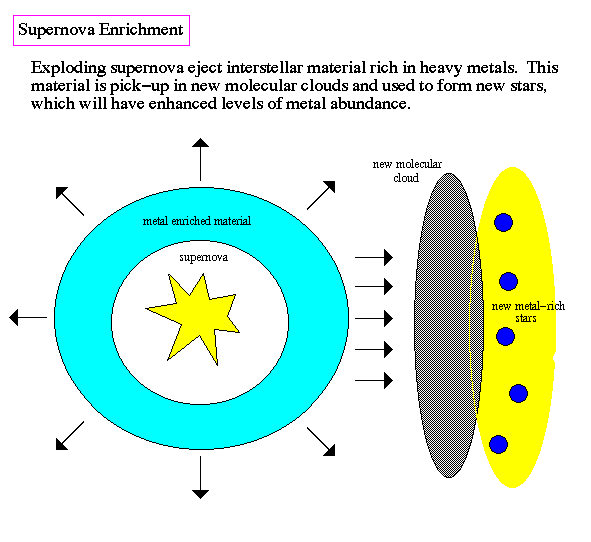
As time passes, each of the gas clouds in the Galaxy will increase in the abundance of elements such as carbon, iron, etc. So the more recent a star has been formed, the richer in heavy elements it is. This is a form of dating system for stars and we deduce that halo stars are the oldest stars in the Galaxy since they have the lowest chemical abundances. The disk stars are the youngest since they are the most metal rich.
Formation of Our Galaxy:
The key to understand how our Galaxy formed is the location, ages and chemical composition of the various stellar populations. The oldest stars are in the halo and bulge. The most metal rich stars are in the disk and bulge. From this we deduce that the halo formed first, followed by the bulge then disk. All the gas is located in the disk (which is rotating) because gas clouds can undergo inelastic collisions.
Inelastic collisions occur when two objects collide and share momentum as a single body. Stars are too small to collide within the Galaxy (their cross section is very, very low). But gas clouds are large and can 'stick' together.
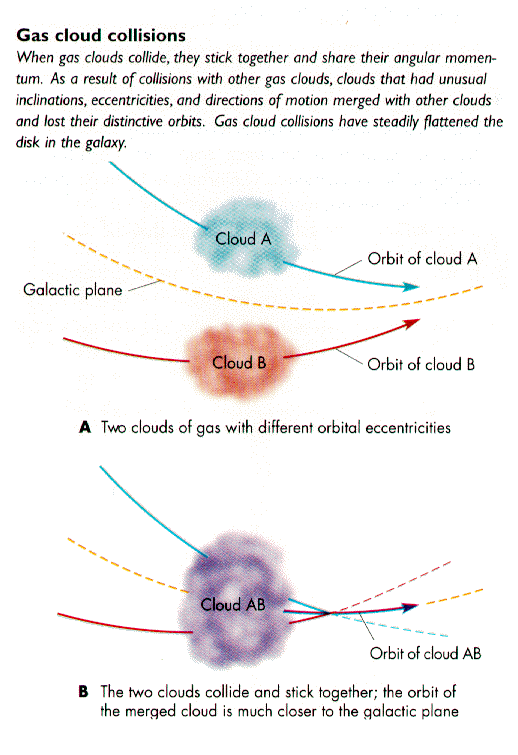
Even the above facts, the formation and evolution of our Galaxy must have taken place through a series of continuous stages. First, the Galaxy began as a large single gas cloud a few hundred of thousand light-years across. Passage near other proto-galaxies caused this large cloud to spin. This rotation was far from organized as currents and smaller clouds formed within the proto-Galaxy.
Spheres of gas containing about a million solar masses of material collapsed first, this will become the future halo globular clusters. These first clouds were very weak in chemical abundance, but the first supernovae in the halo stars begins to enrich the interstellar medium.
Cloud-cloud collisions steadily eliminated those clouds with the greatest inclination and those moving in the opposite directions until the distribution of gas clouds became flatter and flatter. Most of the gas is directed to the bulge regions where the high densities produce a highly dense core region.
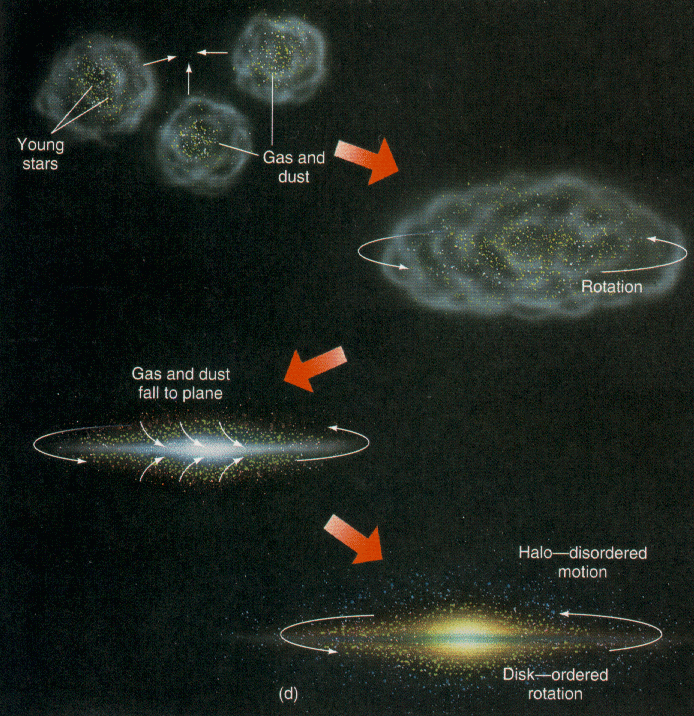
Lastly, the remaining gas settles into the disk where the rotation slows the formation of new stars until spiral density wave form to dominate the appearance of the Galaxy today.

|
|

|